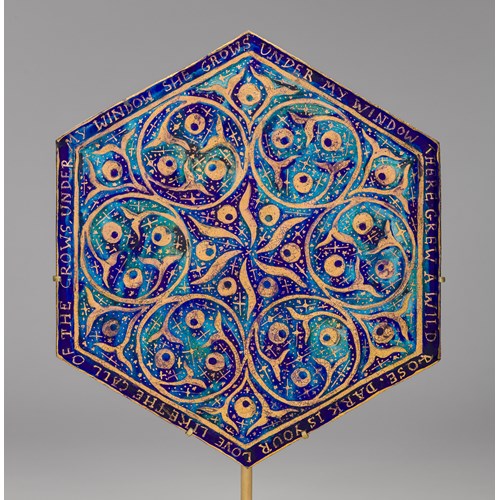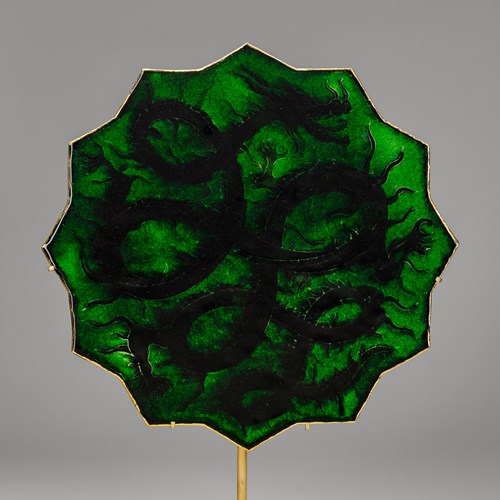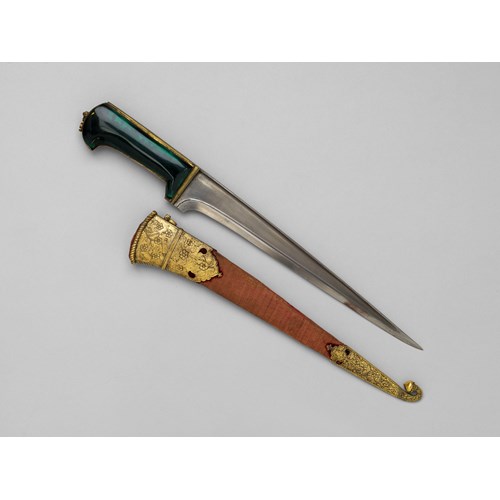Marketplace
A Blue-and-White Ewer
A Blue-and-White Ewer
Epoque Late 17th/early 18th century
Medium Porcelain with underglaze cobalt blue decoration
Dimension 26.5 cm (10³/₈ inches)
This ewer has a pear-shaped body that is flat on both sides. It stands on a wide trumpet-shaped foot and has a narrow octagonal neck, a flat brim and a boat-shaped mouth. It has a tapered octagonal neck with flat brim and boat-shaped mouth, and elegantly curved spout and handle. The belly, spout and handle of the ewer is decorated with various types of flower trees all in similar compositions: in the foreground are pierced rocks, above which branches of blossoming flowers are depicted. Small insects and dragonflies are flying among the flowers. The flowering trees depicted includes chrysanthemum, pomegranate, prunus and possibly peony. The flower scenes are framed by blue diaper patterns. Narrow panels of repeating flower motif appear on the octagonal neck. The flat brim connected to the handle has a circular cloud scroll border, above which are four stylised Chinese characters signifying “longevity”. A petal border and a toothed border surround the mouth. The same petal and toothed borders are used on the foot, a band of “hui” motif and a row of dots link the foot and the body of the ewer. A ewer in polychrome in the Topkapi Saray Museum (TKS26/5039) has identical shape and very similar decorative scheme to our example.
Although the taste for Chinese blue-and-white porcelain in the Middle East and Europe in the early modern period is widely known, its link with the Indian subcontinent remains little explored. A hoard of 14th century Chinese blue-and-white porcelain discovered at Feroz Shah Kotla in Delhi points Indian rulers’ interests in Chinese porcelain since the Delhi Sultanate period. Blue-and-white vessels were later continuously depicted in Mughal manuscript paintings as an essential part of serviceware for royal feasts. It is well-known that blue-and-white porcelains inspired by Middle Eastern metalwork had been produced in China since the 15th century and would have been exported as luxury goods to the Middle Eastern market. Similarly, blue-and-white porcelain modelled on Indian metalwork were exported to the Indian market. Our ewer is an example of this, for its shape can be traced to 17th century Indian metal ewers.
Reference:
Krahl, Regina, Nurdan Erbahar, and John Ayers. Chinese Ceramics in the Topkapi Saray Museum, Istanbul: A Complete Catalogue. London: published in association with the directorate of the Topkapi Saray Museum by Sotheby’s, 1986. P.1177, Cat.2865.
中国,清朝,17世纪晚期或18世纪
高26.5厘米
Stock No.:5351
Although the taste for Chinese blue-and-white porcelain in the Middle East and Europe in the early modern period is widely known, its link with the Indian subcontinent remains little explored. A hoard of 14th century Chinese blue-and-white porcelain discovered at Feroz Shah Kotla in Delhi points Indian rulers’ interests in Chinese porcelain since the Delhi Sultanate period. Blue-and-white vessels were later continuously depicted in Mughal manuscript paintings as an essential part of serviceware for royal feasts. It is well-known that blue-and-white porcelains inspired by Middle Eastern metalwork had been produced in China since the 15th century and would have been exported as luxury goods to the Middle Eastern market. Similarly, blue-and-white porcelain modelled on Indian metalwork were exported to the Indian market. Our ewer is an example of this, for its shape can be traced to 17th century Indian metal ewers.
Reference:
Krahl, Regina, Nurdan Erbahar, and John Ayers. Chinese Ceramics in the Topkapi Saray Museum, Istanbul: A Complete Catalogue. London: published in association with the directorate of the Topkapi Saray Museum by Sotheby’s, 1986. P.1177, Cat.2865.
中国,清朝,17世纪晚期或18世纪
高26.5厘米
Stock No.:5351
Epoque: Late 17th/early 18th century
Medium: Porcelain with underglaze cobalt blue decoration
Dimension: 26.5 cm (10³/₈ inches)
Plus d'œuvres d'art de la Galerie







_T638682403756763695.jpg?width=500&height=500&mode=pad&scale=both&qlt=90&format=jpg)

